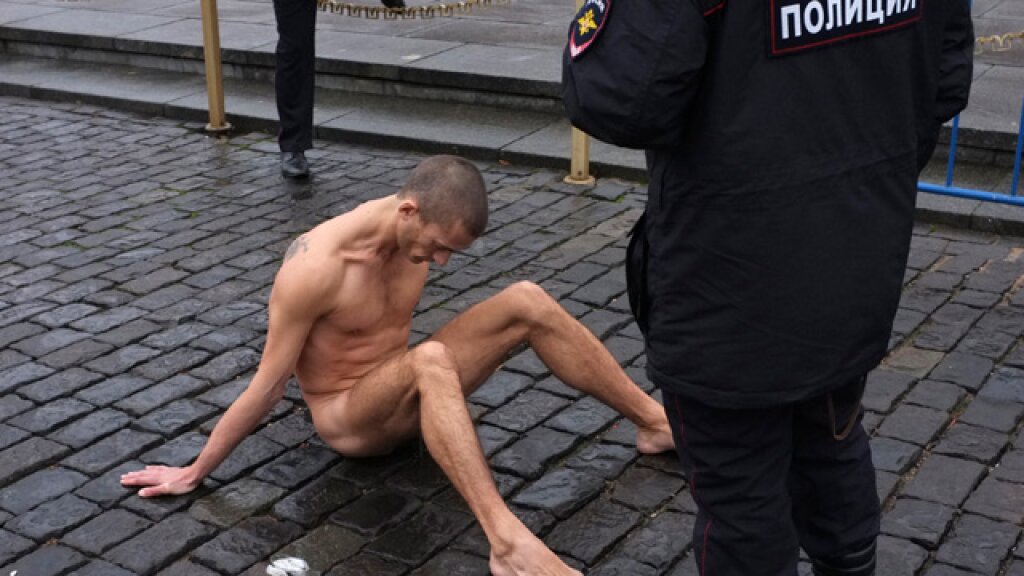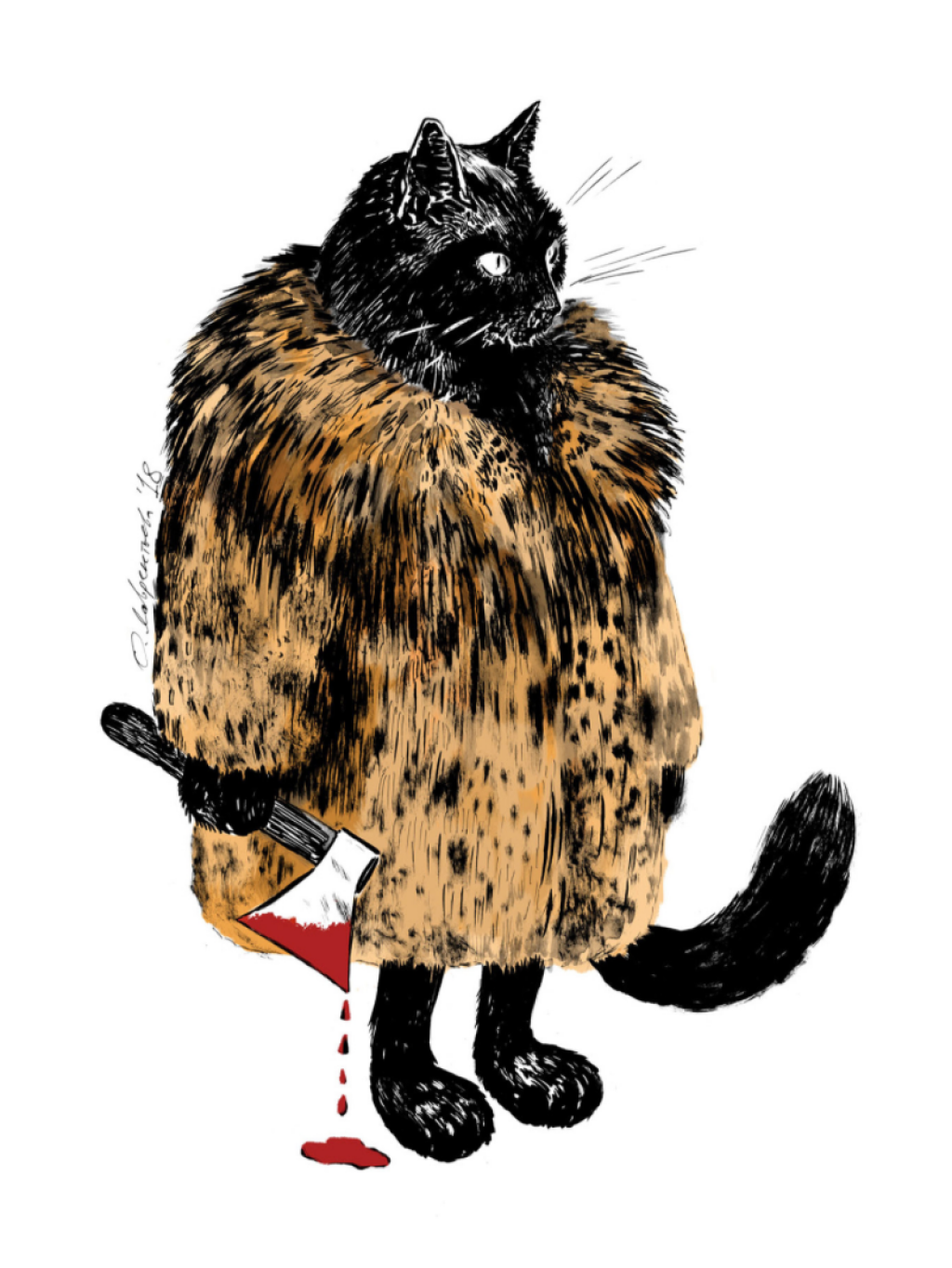Sunday before last, on the drizzly police holiday, Petersburg performance artist Petr Pavlensky (b. 1984) sat stark naked in Moscow's sacred center and nailed his scrotum to the cold cobblestones of Red Square. This art-action, entitled “Fixation,” was videoed and viralized, moving various virtual communities to rapid commentary that ranged from the lofty to the lewd, the sympathetic to the totally disgusted. In the U.S. and Russian corners of the Internet, at least, everyone seemed to have something to say about “Fixation,” all too often, alas, with recourse to the rottenest of puns: witness the title above.
This wasn’t the first time Pavlensky’s painful body of work had gotten folks gabbing the world over. Initial éclat came in July 2012 with “Stitch” [Shov], an art-action in which he sutured his lips together as a metaphor for the Russian government’s gag order on civil society. For a certain slice of viewers, Pavlensky’s spectacle conjured up the specter of queer American artist David Wojnarowicz (1954-1992), whose “Fire in My Belly” from 1986-87 offered an angry rejoinder to the U.S. government’s genocidal denial of the emergent AIDS crisis. In an uncanny coincidence, the video of Wojnarowicz, similarly stitched, was enjoying its own viral afterlife after having been re-censored under pressure from the hateful religious right. But months later, Pavlensky was standing on the steps of Petersburg’s Kazan Cathedral with a needle and thread, and a placard protesting Pussy Riot’s conviction for religious hatred.
Though sufficiently striking to make Reuter’s year-end roster of notable photos, Pavlensky’s piercing image faded in the months that followed. Likewise, the daily noise surrounding Pussy Riot, and more specifically, the collective’s most modelesque member, Nadezhda Tolokonnikova AKA Nadya Tolokno (b. 1989), died down (outside of academia anyway), excepting a few self-authored statements and prison interviews in the Russian press, reprinted in full in oppositional English-language outlets, like chtodelat (recently closed) and n+1 (still going strong). A year after “Stitch” and the PR3’s conviction, n+1 published Tolokonnikova’s appeal before the Supreme Court of the Republic of Mordovia, in which she railed against the ‘rapey-ness’ of the Russian legal system and its deployment of Putinism’s patriarchal aesthetic to compel female bodies to consent.
Everywhere—in schools, prisons and universities, at voting stations and sitting in front of the TV—we are taught to obey, to lie, to bite our tongues, to say “yes” when we want to say “no.” The great cause of our civilization is to foster in ourselves, our children and friends an antidote to this obedience—an obedience that eats people alive... I am proud of all those who are prepared to sacrifice themselves and defend their principles. This is the only way that great transformations in politics, values and aesthetics ever come to pass.
The appeals court said “no,” making Nadya bite her tongue until she disobeyed in an open letter (also published in translation on n+1), which begins:
On Monday, September 23, I am declaring a hunger strike. This is an extreme method, but I am absolutely convinced it is my only recourse in the current situation. The prison wardens refuse to hear me. But [...] I will not remain silent [...] I demand we be treated like human beings...
The intervening weeks witnessed tempestuous debates among Russian netizens about Tolokonnikova’s consecutive hunger strikes and hospitalizations. Meanwhile the Western press was relatively hushed...that is, until a couple of weeks ago, when rumors that she’d been swallowed up by the vast post-Soviet prison system started to surface. Masha Gessen, the liberal U.S.‘s most reliable source on Russia, updated her New York Times blog with the evocatively-titled post, “Where Is Nadya of Pussy Riot?” (November 4, 2013). No doubt this was a nod to the catchphrase attached to disappeared Chinese dissident--Where Is Ai Weiwei?-- whose namesake shares with Tolokno the difficult plight of an artist resisting a repressive regime in the erstwhile second world.
But for all the interest of such a comparison, Gessen’s blog post pivots on another biographical parallel by way of bibliographic detail: not long after her sentencing and settlement in the penal colony in Mordovia, Tolokonnikova ordered a copy of Anatoly Marchenko’s My Testimony [Moi pokazaniia], the first of three samizdat memoirs by the lifetime camp inmate before he supposedly succumbed to stroke induced by sustained hunger-striking. Despite the half-century wedge between feminist performer and late-Soviet dissident, there are remarkable similarities between their lives and struggles which Gessen spends the length of the article limning, and which, in the absence of actual facts about Nadya’s whereabouts, portend a grim end to the second part of this intergenerational saga. (Readers will be somewhat relieved to know Tolokonnikova has since been discovered in a Siberian prison hospital.)
Gessen’s next entry a week later had nothing to say about Nadya, and turned instead to the scene of “Self-Mutilation on Red Square,” making only vague gestures to Pavlensky’s Pussy Riot connection via “Stitch.” But there may be tauter threads pulling these posts together: the last detail of Tolokonnikova’s prison life and Pavlensky’s most recent performance are bound by the book. Indeed, Marchenko studs My Testimony with Pavlenskian episodes, devoting a chapter exclusively to the practice of “self-mutilation” or chlenovreditel’stvo--a compound Russian word whose semantic particles should be read on their face in Pavlensky’s case, as harm done to one’s member. MT’s grotesque acts run the gamut from swallowing spoons and sundry objects of camp byt to bloodletting and drinking, facial tattooing and ear amputation, a set of gestures often accompanied by individual hunger strike. The mutilation section focuses on a certain Sergei K., a criminal inmate in Mordovia, who, like Tolokonnikova, was “driven to such total desperation by the futility of any kind of protest against starvation, abuses of power, and injustice, that,” like Pavlensky,
he decided, no matter what it took, he would maim himself. He got a hold of some pieces of pipe somewhere, fashioned them into a hook, and fastened them to some wood (he tied them together with thread from his unraveled socks). A bit earlier he came by a pair of nails, which he hid in his pocket during searches. One nail, the smaller of the two, he beat with a tureen into a food bowl—he beat it in very quietly, trying not to clank it, so that the wardens wouldn’t hear. With this nail he attached the wood to the hook…[The other cellmates] bustled around Sergei, but there was nothing for them to do: the nail was deeply embedded in the bench, and Sergei was just sitting there in his birthday suit nailed down by the balls.
In contrast to the crass rubbernecking and abstract philosophizing inspired by “Fixation,” Marchenko observed these rash stabs at subjectivity with reciprocal silence, seeing his role as that of bearing witness without judgment or analysis. This “happened right before my eyes in the spring of 1963,” he reports, and “we, the rest of the cons in the cell, watched him in silence. I don’t know who was feeling what while this was going on, but to interfere, as I have already said, is out of the question: every man has the right to dispose of himself and his life in any way he wants to.”
Marchenko wasn’t the only prisoner to document these desperate gestures by common criminals in the camp. The famously anti-Soviet author Andrei Sinyavsky (samizdat pseudonym Abram Tertz, 1925-1997) talked about them too, in a lecture he delivered to a small gathering of Western intellectuals in Geneva in 1975.[1] Speaking as a survivor himself, Sinyavsky despaired that such acts of “self-eating” [samoedstvo], as he christened them, were not understood as art but “easily explained away as perversion, psychopathy,” meeting neither with applause by the cultured elite in the cold war East, nor sympathetic pause by the defenders of human rights in the West. Rather they were regarded with contempt “even in our [Soviet] camp literature,” causing no real ripples in rights discourse abroad. But Sinyavsky saw a “moral exigency” in the search for meaning, however doomed to failure, in asking of the silent self-eater, “What does he mean to say by all that?” What does he mean to say by “using the ‘anchor’”--to employ prison parlance for what happened on Red Square last Sunday? Pavlensky had the freedom to subtitle his symbolism with an artist’s statement, not to mention the savvy analyses of the Russian art world. By contrast, the silence of Sinyavsky’s anchor-wielding self-eaters was absolute, constituting “a break in communication” so consummate, a gesture of “final, total nonacceptance” so complete, that it couldn’t transmute solitary bodies into social metaphors. It could only point at the alienated prisoner’s double “confinement in language,” and manifest his “unwillingness to participate in the system of relations proposed to him, and his refusal of the hateful form of communication the regime had imposed on him.” Here we hear an anticipatory echo of Tolokno.
When Sinyavsky first introduced the gulag’s mute self-mutilators to academics in the West, they came up with the same comparisons to Viennese Actionism and seventies performance art (think Abramovic and Burden) that post-Soviet intellectuals sallied forth four decades later. But these listeners also missed the point, in Sinyavsky’s opinion, by forcing their liberal humanist content into the criminal’s illiberal, inhuman form, and finding their own cherished values embedded in gestures whose very senselessness was a matter of the system’s own brutal absurdity. Alongside them, Pavlensky’s explanation of “Fixation” as a metaphor for society’s melancholic fixation on its losses and consequent fixity in the field of political action sounds inversely neat and on the nose. Publicly striking a nail into his member, Pavlensky had hoped to strike a blow against the metastasizing “police apparatus and forces of coercion” by opening the Russian people’s’ sleep-encrusted eyes to the way “the country is beginning to resemble one big zone, one big gulag.”
Sinyavsky/Tertz hit a consonant note in A Voice in the Chorus back in 1973: “ From any distance [the camp] is the center [of Russia].” The difference is that Sinyavsky had done time in that arbitrary center, spent years in the company of those anonymous non-people who had sacrificed their physical selves for a shot not at abstract human rights so much as real human dignity, whose awful acts aimed somehow to make them seen even when only the walls were watching. It matters, then, that Pavlensky doesn’t dignify his formal indebtedness to these prisoners for both “Stitch” and “Fixation” when asked in widely disseminated interviews. (And that the police officer on Red Square addressed him first respectfully, Uvazhaemyi, vstaem.) In lieu of this, Pavlensky employs the privatized idiom of postmodernism to explain how “primacy or originality” weren’t at stake in his nail, meaning what criminals did “had no meaning of any kind for [him]” as he was grasping for “a gesture that would perfectly reflect his situation.” A tactic in such solipsistic terms would seem incapable of effecting “great transformations in politics, values and aesthetics,” if we follow the recipe for revolution Nadya cooked up in the penal colony with “those [people] who are prepared to sacrifice themselves” so that others won’t be “eaten alive” by the system.
Of course, meaning-making is never sui generis. And Pavlensky’s “fixated” text has undeniable intertexts in the camp memoirs of Marchenko, Sinyavsky, and others. It also has context in the words and acts Tolokonnikova authored while in confinement. In the wider symbolic field they all share, Pavlensky’s protracted performance en plein air--surrounded by the tourists and high-end department stores of the new Red Square--brings into relief the real immobility and more-than-metaphorically “bare life” of gulag lifers.[2] His naked body looks a bit like matter out of place and time here, a symbol of unfreedom liberated from the chain of imprisoned signifiers, and set adrift along the globalized flows of information and capital after the Cold War. By narrowing our gaze to a single private citizen, we the people of the Internet make more ghosts of the penal systems--both Russia’s and our own--and diminish the full impact of Pavlensky’s act and the punitive threat he now faces. What I mean to say by all this is simple: that some part of the performance’s potency resides in the history from which Pavlensky unhooks it, and without which “Fixation” risks becoming an anchor unanchored.
[1] Of note, Sinyavsky’s codefendant in the watershed, Thaw-ending show trial of 1966, Yuly Daniel, did time in Mordovia with Marchenko, and appears as a character in My Testimony.
[2] The quickness with which Pavlensky travels between states of self-induced stasis--or strolling on his own recognizance--and involuntary holding by agents of the state is accentuated by the preface to his Snob.ru interview: “24 hours after his action on Red Square, the artist Petr Pavlensky was released from custody. Four hours after that he was strolling along Clean Ponds, and talking to a ‘Snob’ correspondent about his fears and hopes, and how to properly nail one’s scrotum to a plank.”



